Jewelweed
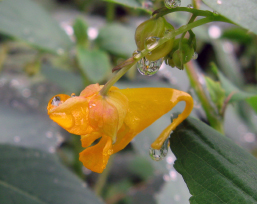 There’s a game you can play with Jewelweed (Impatiens capensis). Found in damp areas such as the edge of a pond, this plant bears intricate orange and yellow flowers that soon turn into slender green seed pods. When you find some of these pods, remove them by snapping their thin stems. Then casually pass them to a friend.
There’s a game you can play with Jewelweed (Impatiens capensis). Found in damp areas such as the edge of a pond, this plant bears intricate orange and yellow flowers that soon turn into slender green seed pods. When you find some of these pods, remove them by snapping their thin stems. Then casually pass them to a friend.
Your reward will be a yelp of surprise, and possibly some unkind words about duplicitous botanists. Jewelweed seed pods are spring-loaded. They explode at the lightest touch, shooting seeds everywhere.
This plant is tougher than it looks.
With a frail, hollow stalk and thin leaves, delicate Jewelweed has a tropical appearance. Indeed, the first frost of the year instantly kills it. The plant makes up for this weakness by growing quickly, by producing some self-pollinating flowers in case the bumblebees and hummingbirds fail to do the job, and, of course, by spreading its seeds far and wide through the judicious use of explosives.
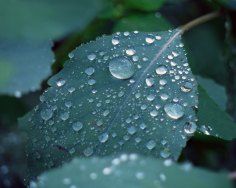 The name ‘Jewelweed’ might come from the way that tiny hairs on the leaves cause rainwater to bead up in shimmering pearls. The scientific name may derive from the impatient way that the plant distributes its seeds. It also shows Jewelweed’s relationship to the Impatiens in your garden, which, coincidentally, also produces explosive seed pods.
The name ‘Jewelweed’ might come from the way that tiny hairs on the leaves cause rainwater to bead up in shimmering pearls. The scientific name may derive from the impatient way that the plant distributes its seeds. It also shows Jewelweed’s relationship to the Impatiens in your garden, which, coincidentally, also produces explosive seed pods.
Jewelweed is one of the few native plants that can stand up to the vigorous invader Garlic Mustard. In the war against invasive species, it’s sometimes best to roll out the artillery.
Poison Ivy
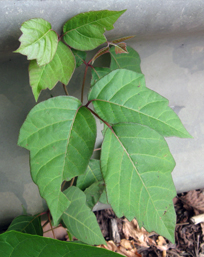 Okay, enough with the European transplants. This week I feature one of those surprisingly durable North American plants that survived the transition from forest to suburban landscape to cityscape. When you come across a patch of Poison Ivy in your neighborhood, feel free to congratulate it on sticking it out as our urban neighbor for all those decades; apparently all it takes is the ability to generate fist-sized blisters on human skin.
Okay, enough with the European transplants. This week I feature one of those surprisingly durable North American plants that survived the transition from forest to suburban landscape to cityscape. When you come across a patch of Poison Ivy in your neighborhood, feel free to congratulate it on sticking it out as our urban neighbor for all those decades; apparently all it takes is the ability to generate fist-sized blisters on human skin.
Poison Ivy, which bears the ominous scientific name Toxicodendron radicans, likes living on the edge. It thrives in those thin waste spaces between scraps of forest and development, places where it doesn’t get too much shade. In effect, it lurks.
How can you identify this plant? There are plenty of catchy mnemonic devices about Poison Ivy, from the well-known “Leaves of three, let it be” (a good general rule, except that about a zillion other plants have three leaves) to other more creative and often less accurate rhymes. To me, the best way to identify it is to look at lots of pictures until you have a good general idea. Poison Ivy sometimes has red leaves and sometimes not, sometimes hairy leaves sometimes not, sometimes jaggety leaves and sometimes not. Also, in the fall and winter it’s reduced to a stick that is covered in deceptively adorable white berries.
Here are some things that you should not do with Poison Ivy:
- Set fire to a pile of it, and then inhale the fumes.
- Liquefy a large vine with a chainsaw.
- Let your pooch run through it and straight into your loving arms.
- Use your 5-iron to knock your golf ball out of it, and then touch your golf ball.
- Scamper about in it one moonless evening with that cute guy from your baking class.
- Touch anything that has touched it.
- Look at it the wrong way.
- Say its name three times into a mirror on the solstice.
Poison Ivy exists in a remarkable balance; it’s just offensive enough to protect itself, and just tenacious enough that we can’t seem to get rid of it. Unlike other threatening lifeforms that we eliminated from many of our towns (like rattlesnakes), it persists, a subtle reminder that the natural world isn’t all daisies and roses.
Queen Anne’s Lace
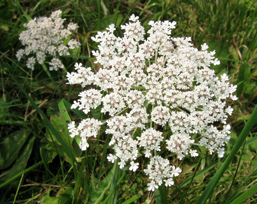 If you drive on virtually any highway in the Northeast right now, you’ll see the flowers of this plant swarming in the waste places along the side of the road, crowding right up to the edge of the highway as if they’re teenage fans and you’re a 19-year-old music star with a baby face and hair like a lion’s mane. This is yet another Old World plant that has become very common in North America.
If you drive on virtually any highway in the Northeast right now, you’ll see the flowers of this plant swarming in the waste places along the side of the road, crowding right up to the edge of the highway as if they’re teenage fans and you’re a 19-year-old music star with a baby face and hair like a lion’s mane. This is yet another Old World plant that has become very common in North America.
Queen Anne’s Lace (Daucus carota) is also known as Wild Carrot. The big orange carrot that we eat in salads belongs to the same species, and it likely originated from the selective breeding of an especially palatable subspecies of Daucus carota that was found in Afghanistan. We decry it as a weed in one context, and then pay money for its julienned cousin in another context — it’s a good thing plants can’t chuckle.
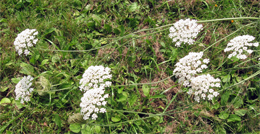 The name Queen Anne’s Lace is particular to North America. The flower looks an awful lot like lace, and there is a little red bloom in the center that colonial folks thought looked like blood — the story goes that Queen Anne pricked her finger while she was sewing the lace, and a drop of blood landed in the middle of her doily. I don’t know why Queen Anne in particular gets picked on here. She was definitely a fiery character, but I don’t think her lace sewing was anything to crow about.
The name Queen Anne’s Lace is particular to North America. The flower looks an awful lot like lace, and there is a little red bloom in the center that colonial folks thought looked like blood — the story goes that Queen Anne pricked her finger while she was sewing the lace, and a drop of blood landed in the middle of her doily. I don’t know why Queen Anne in particular gets picked on here. She was definitely a fiery character, but I don’t think her lace sewing was anything to crow about.
Look for the lacy white flowers in fields and waste places, and dig up the young root for a little carroty snack. Better yet, affix it to your lapel; you’ll smell like a fresh garden salad, and you can challenge your date to lean in real close and find the one red bloom.
Chickory
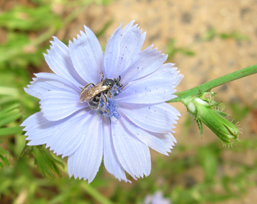 For me, this cheerful, sprawling, unpretentious plant embodies the carefree nature of my childhood summers in the Northeast. Like so many other parts of my botanical nostalgia, however, Chickory (Chichorium intybus) is native to Europe and a relative newcomer to this continent.
For me, this cheerful, sprawling, unpretentious plant embodies the carefree nature of my childhood summers in the Northeast. Like so many other parts of my botanical nostalgia, however, Chickory (Chichorium intybus) is native to Europe and a relative newcomer to this continent.
My childhood Chicories were direct descendants of escapees from colonial gardens. You might have eaten this species in a fancy restaurant, in a variety known as Radicchio. It’s also very closely related to Endive. This makes me wonder how many other scraggly roadside plants we scoff at, and then solemnly purchase at great cost when they’re in a slightly different format.
 Back in World War II when people were tightening their belts, Chicory was used as a cheap local coffee substitute. This surprises me because Chicory contains absolutely no caffeine. Perhaps people drank it because it was just as appealingly caustic as coffee? Studies show that farm animals feeding on Chicory have a significantly reduced population of parasitic worms in their systems. Yum.
Back in World War II when people were tightening their belts, Chicory was used as a cheap local coffee substitute. This surprises me because Chicory contains absolutely no caffeine. Perhaps people drank it because it was just as appealingly caustic as coffee? Studies show that farm animals feeding on Chicory have a significantly reduced population of parasitic worms in their systems. Yum.
Add these dubious qualities to the fact that Chicory can aggressively displace native plants, and perhaps it’s best enjoyed as a warm fuzzy part of your childhood memories. Ah yes, those hazy, lazy summers, long before you knew anything about intestinal parasites or decaf.
American Chestnut
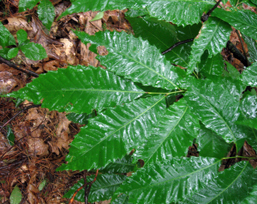 You’d have a hard time finding today’s plant on a walk through the city. In most cases it has been completely wiped out, or it’s just a shadow of its former self. But its story is so monumentally tragic, and has so much to say about our interaction with plants, that it’s worth telling. Plus, it has a sci-fi ending!
You’d have a hard time finding today’s plant on a walk through the city. In most cases it has been completely wiped out, or it’s just a shadow of its former self. But its story is so monumentally tragic, and has so much to say about our interaction with plants, that it’s worth telling. Plus, it has a sci-fi ending!
The American Chestnut (Castanea dentata) was once one of the most common trees in eastern North America. It took up a quarter of the hardwood canopy, and could reach a height of 100 feet. Its nuts were an invaluable food for animals, as well as the inspiration for the lyric “Chestnuts roasting on an open fire…”.
In 1904, a forester noticed that some of the Chestnut trees in the New York Zoological Garden were suffering from an unusual disease. Called the Chestnut blight, it likely originated from Asian chestnut trees that were sold in nurseries. The American Chestnut had no immunity to the foreign pathogen. It traveled rapidly outward from the New York area, and by the early 1950s most of the great American Chestnut trees were gone.
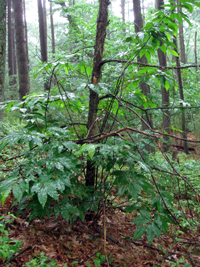 When we walk through lush eastern forests today, it’s hard to imagine that one of the most important trees is missing. You can still find American Chestnut wood fences and cabins that stand incongruously in a Chestnut-free forest. Even more strangely, you can sometimes find a small shrubby Chestnut just a few feet high, as in this photo (right) — doomed little sprouts growing from a trunk that was destroyed by disease.
When we walk through lush eastern forests today, it’s hard to imagine that one of the most important trees is missing. You can still find American Chestnut wood fences and cabins that stand incongruously in a Chestnut-free forest. Even more strangely, you can sometimes find a small shrubby Chestnut just a few feet high, as in this photo (right) — doomed little sprouts growing from a trunk that was destroyed by disease.
We almost completely destroyed the American Chestnut, and strangely, we’re now engineering its return. Scientists are creating a blight-resistant American Chestnut. Here’s the plan: first they cross some of the few remaining healthy trees with Asian trees, and then they breed them until they’re mostly American Chestnut. Like so many other plants, this tree’s future is now inseparable from our own.
Echinacea
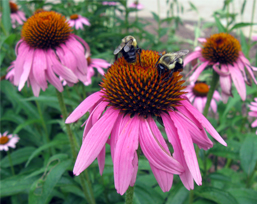 Maybe you’re the kind of person who, when confronted with a sick coworker, immediately whips out a bottle of Echinacea supplement pills. As you place the bottle on your coworker’s desk to avoid contact with her pestilence-ridden hands, then nonchalantly back away until you reach the safety of your cubicle, you will probably have enough time to consider that you might’ve walked past a real live Echinacea plant on your way to work.
Maybe you’re the kind of person who, when confronted with a sick coworker, immediately whips out a bottle of Echinacea supplement pills. As you place the bottle on your coworker’s desk to avoid contact with her pestilence-ridden hands, then nonchalantly back away until you reach the safety of your cubicle, you will probably have enough time to consider that you might’ve walked past a real live Echinacea plant on your way to work.
Echinacea is the genus name for a group of coneflowers. One of the most familiar species in the eastern half of North America is the Purple Coneflower (Echinacea purpurea). It’s related to daisies and sunflowers, and it’s popular in city gardens.
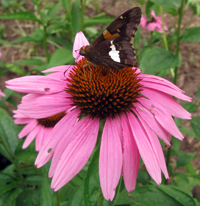 The name Echinacea comes from the Greek word for spiny — note the flower’s spiny center. When I learned this, I thought, “Aha! That must be why spiny echidnas are called spiny echidnas.” I even started to see a tiny rolled-up echidna at the center of each coneflower. Sadly, the word echidna comes from a completely different Greek root. I still think it’s a good way to remember the plant’s name, even if your command of Greek is lacking.
The name Echinacea comes from the Greek word for spiny — note the flower’s spiny center. When I learned this, I thought, “Aha! That must be why spiny echidnas are called spiny echidnas.” I even started to see a tiny rolled-up echidna at the center of each coneflower. Sadly, the word echidna comes from a completely different Greek root. I still think it’s a good way to remember the plant’s name, even if your command of Greek is lacking.
How effective is Echinacea at fighting the common cold? Feel free to launch into the debate at the entertaining (and infuriating) Wikipedia Talk page for Echinacea. I’m much more interested in watching butterflies and bumblebees visit the city gardens where this flower grows in happy obscurity, unaware that the people passing by have bits of Echinacea in bottles in their purses.
Ginkgo biloba
I’ve moved to a new city and started a new job, so I’m going to cut the number of posts down to one a week. I’ll update on Mondays, barring extenuating circumstances. Thanks for reading!
You might be more fa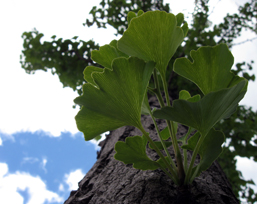 miliar with today’s plant when it’s found in products like energy drinks and traditional medicines. Believe it or not, many of our city streets are lined with Gingko biloba trees, and they have a peculiar history.
miliar with today’s plant when it’s found in products like energy drinks and traditional medicines. Believe it or not, many of our city streets are lined with Gingko biloba trees, and they have a peculiar history.
The Ginkgo is a living fossil. It might look like any other tree from far away, but take a close look at those weird clusters of wedge-shaped leaves — they were a familiar sight to ancient reptiles that walked the Earth long before dinosaurs.
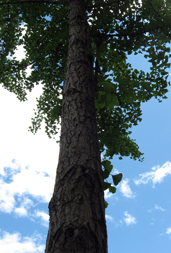 For a time, the Ginkgo tree spread throughout the globe. Eventually, however, this tree could no longer compete in a world filled with modern plants. About two million years ago there were so few Ginkgos that they no longer showed up in the fossil record. The Ginkgo tree still hung on in some parts of China, but times looked tough. Fortunately, it was about to see another international resurgence.
For a time, the Ginkgo tree spread throughout the globe. Eventually, however, this tree could no longer compete in a world filled with modern plants. About two million years ago there were so few Ginkgos that they no longer showed up in the fossil record. The Ginkgo tree still hung on in some parts of China, but times looked tough. Fortunately, it was about to see another international resurgence.
At some mysterious point in history, a few humans decided that the Ginkgo tree was useful and attractive. They began to cultivate it far outside of its native range. Eventually, people carried this tree outside of Asia and spread it to urban areas around the globe.
Nowadays there is no unquestionably native population of Ginkgo trees — that is, there is no population that wasn’t planted by people. But once again this species flourishes internationally. The future of the Ginkgo tree is now inextricably connected with the future of the human species, like so many other plants in the urban jungle.
Creeping Bellflower
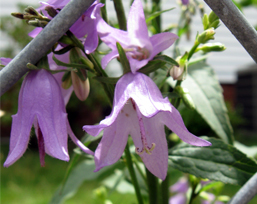 This beautiful, delicate-looking plant is serious trouble. It’s been described as a hellcat, unruly and horribly invasive. “If it has a weakness I am unaware of it,” says one author, using a tone normally reserved for zombies.
This beautiful, delicate-looking plant is serious trouble. It’s been described as a hellcat, unruly and horribly invasive. “If it has a weakness I am unaware of it,” says one author, using a tone normally reserved for zombies.
Creeping Bellflower (Campanula rapunculoides) was brought here from Europe because it’s a beautiful garden plant. It is also adept at surviving in urban and cultivated areas. It can squeeze through even the tiniest cracks in the pavement. You can’t kill it by yanking it up, because it can regrow from the smallest pieces of root left in the ground. Its deep and powerful root system can’t be eliminated by mere mortals.
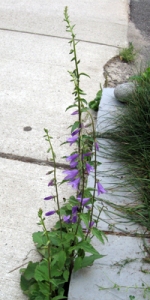 To identify Creeping Bellflower, look for stalks up to 3 feet high with blooms on one side of the stalk. The flowers are bell-shaped and open into a five-pointed star. There are some local native bellflowers that look a little bit similar, but none is as spectacular, and none will colonize sidewalk cracks in the same aggressive way. Before the flowers have arrived, the plant is low to the ground and inconspicuous.
To identify Creeping Bellflower, look for stalks up to 3 feet high with blooms on one side of the stalk. The flowers are bell-shaped and open into a five-pointed star. There are some local native bellflowers that look a little bit similar, but none is as spectacular, and none will colonize sidewalk cracks in the same aggressive way. Before the flowers have arrived, the plant is low to the ground and inconspicuous.
Most weed guides suggest destroying Creeping Bellflower with powerful chemicals, or digging up the entire affected area, including a substantial buffer zone. Alternately, you can sit on your porch and watch the purple flowers sway in the breeze, resigned to a life under the control of your beautiful bellflower overlords.
White Clover
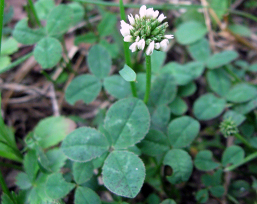 When kids hunt for four-leafed clovers, they’re usually searching through the clumps of White Clover (Trifolium repens) that blanket our lawns and parks. It’s hard to believe that a plant this common in our cities was absent from North America just a few hundred years ago. It’s yet another species that was brought here by European settlers.
When kids hunt for four-leafed clovers, they’re usually searching through the clumps of White Clover (Trifolium repens) that blanket our lawns and parks. It’s hard to believe that a plant this common in our cities was absent from North America just a few hundred years ago. It’s yet another species that was brought here by European settlers.
As with many weeds, White Clover blurs the boundary between pest and friend. It spreads so well that it can displace native plants. However, White Clover is a member of the pea family, and like many of its relatives it performs an invaluable service.
Plants need nitrogen to grow — as do people, since without it we’d have no protein and no DNA. Unfortunately, the nitrogen floating around in the atmosphere is stuck in a form that’s useless to most living things. The roots of White Clover have round nodules that provide ideal housing for special bacteria, and these bacteria turn atmospheric nitrogen into useful nitrogen.
White Clover is a nutritious food for livestock and for wild browsers like deer. It’s a good plant for a lawn because it doesn’t need much mowing. Also, when insect pests destroy the grass, White Clover eagerly fills in the blank spaces.
So why call it a weed? Shockingly, there’s some evidence that White Clover might have been the victim of a slanderous marketing campaign in the 1940s. Companies that developed herbicides for lawns weren’t able to create a mixture that would spare White Clover but eliminate other weeds, so they declared it a weed, too. Innocent helper or nefarious invader? Our lawns are full of complicated characters.
Sensitive Fern
 Ferns can seem pretty unremarkable at first. They don’t have spectacular flowers — in fact, they don’t have flowers at all. They’re kind of like a bass player in a band; they’re subtle and unassuming, but absolutely critical and really cool, and everything is just tacky without them.
Ferns can seem pretty unremarkable at first. They don’t have spectacular flowers — in fact, they don’t have flowers at all. They’re kind of like a bass player in a band; they’re subtle and unassuming, but absolutely critical and really cool, and everything is just tacky without them.
Ferns are very ancient. They dominated the land long before the dinosaurs. As a result, their reproductive cycle is weird and somewhat primitive. They produce spores, and these develop into a romantic heart-shaped structure that has both male and female sex organs. With the help of water, sperm swim from the male part of the structure to the female part, and this union produces the baby fern. Flowering plants eventually overshadowed the ferns because they figured out how to get it on without this lubricating water.
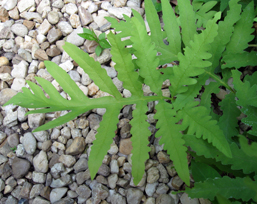 The Sensitive Fern is found in the eastern half of North America, and also in East Asia. It’s a good fern to learn first because it has a unique look. It’s bright green, and it has a “rough” shape, as if a kid did a sloppy job of cutting it out of a piece of construction paper. It keeps its spores in a separate brownish leaf that appears in about July.
The Sensitive Fern is found in the eastern half of North America, and also in East Asia. It’s a good fern to learn first because it has a unique look. It’s bright green, and it has a “rough” shape, as if a kid did a sloppy job of cutting it out of a piece of construction paper. It keeps its spores in a separate brownish leaf that appears in about July.
Early European settlers in North America gave the Sensitive Fern its name because it shrivels at the first hint of frost. It also has demanding needs in terms of moisture and shade. But the Sensitive Fern makes up for this sensitivity by packing powerful toxins that can seriously harm any animal that decides to take a bite.
In the urban environment, the Sensitive Fern is often found in shady gardens, playing steady bass to the electric guitars and trumpets of the flowers, and lookin’ cool.